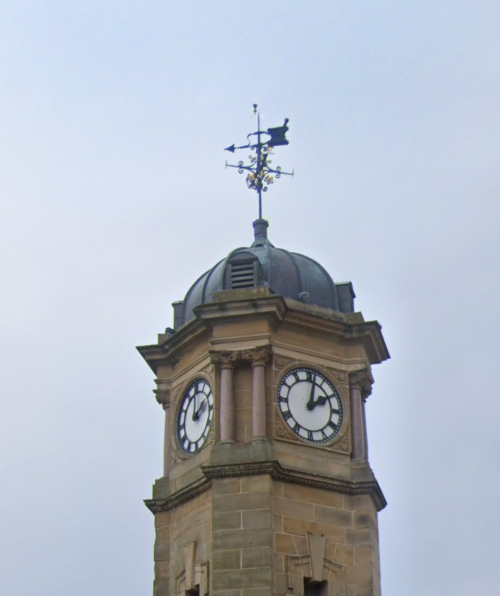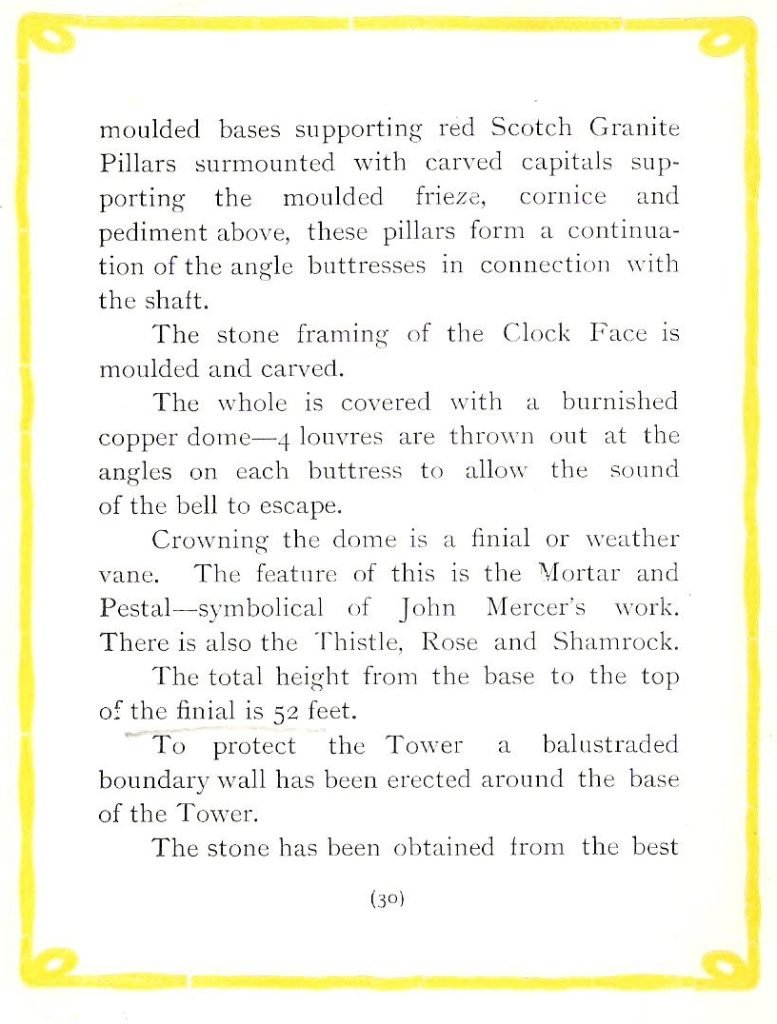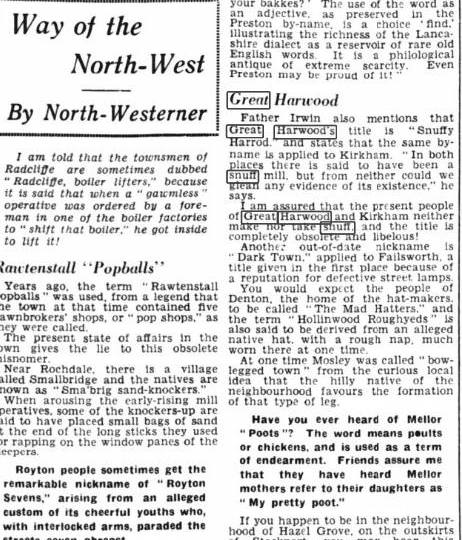Great Harwood has long been known as Snuffy ‘Arrod. Ask any group of people why and you most often get one of two answers: either the people used a lot of snuff because in a town of cotton mills a pinch of snuff helped the workers sneeze out any cotton fibres in their airways; or because snuff was made in Great Harwood – the latter being the more common explanation. What are the facts though? In this essay I’ll examine a variety of sources to attempt to say, definitively, how the name Snuffy Arrod came about.
Harwooders are known to have a great pride in the town, both in the past and in the present. In her book, ‘People and Places of Great Harwood’ Louie Pollard starts with a quote from an election meeting in Blackburn some years ago:
“Is there a better country on the face of the earth, is there a finer land in which to live than this England of ours? “Aye”, came a voice from the back of the room, “Great Harwood”.
Great pride was taken in the appearance of the town by the inhabitants, steps had to be washed and stoned every week no matter what and even back streets were kept spick and span. There was a saying about the people that, ‘Every man owned his own house and the house next door’. Which really isn’t possible and could have originated as a disparaging remark by the Claytoners and the Rishtoners, with whom there was a not always friendly rivalry.
There is one ‘legend’ that often appears – and that is the one that states the town’s links with snuff are celebrated by a snuff box on top of the Mercer Memorial Clock on the Town Gate. The clock commemorates John Mercer the chemist, and the box on top of the clock is a mortar and pestle.

John Mercer Memorial Clock Tower with mortar and pestle

Mercer clock tower souvenir describing the weather vane as a mortar and pestle.
The origins of the term crops up on a regular basis on message boards and Facebook groups, and sometimes in newspapers (online nowadays), and a couple of time on seemingly knowledgeable websites. Here are some examples:
Lancs Live:
“Great Harwood is known locally as “snuffy ‘Arrod” in reference to the town’s history of snuff manufacture.”
https://www.lancs.live/news/local-news/great-harwood-and-rishton-1267124
Cargo Handbook:
“Snuff powder originated in the UK town of Great Harwood and was famously ground in the town’s monument prior to local distribution and transport further up north to Scotland.”
https://www.cargohandbook.com/Tobacco
Accrington Web:
“My dad told me my mum was a snuffy harroder. He didn’t explain the term but implied it meant ‘posh’.”
“Depends what part of it – some of it used to be old factories and wasteland but up the hillier parts more well to do -rich. Smaller version of black burn really.”
Snuffy Arrod coming about from the excessive use by cotton workers is easily discounted. Almost every Lancashire town had its share of cotton mills, and they would all have the same problem with cotton fibres, and it is very likely that people in other towns would have taken similar amounts of snuff to anyone in Great Harwood.
That the name came about because snuff was made here takes a little bit more investigation. Firstly, we need to look at the history of snuff, not just in Lancashire but across the globe.
This is from Britannica.com:
Some of the first peoples known to use snuff were the natives of Brazil. In the late 15th century, members of Christopher Columbus’s crew observed indigenous Caribbean peoples inhaling a snufflike preparation of tobacco. The following century, the practice of inhaling tobacco powder was popularized in France, following the introduction of the tobacco plant from Portugal by French diplomat and scholar Jean Nicot. Nicot, who had been to Lisbon, where he learned of the plant’s medicinal properties, reportedly gave the queen of France, Catherine de Médicis, tobacco leaves and showed her how to prepare a medicinal powder from them. Inhaling the powder as a preventive became popular among the French court. Also in the 16th century, the inhaling of powdered tobacco was practiced by the Dutch, who referred to it as snuff, short for snuftabak (from the words meaning “sniff” and “tobacco”). Tobacco and the practice of snuffing spread rapidly throughout Europe, taking hold in England around the 17th century. During the 18th century, snuff taking became widespread throughout the world.
https://www.britannica.com/topic/snuff
This site about Kendal snuff shows that snuff manufacture was a large undertaking. Kendal was known for snuff, as was Glasgow and Sheffield. However, there were numerous smaller manufacturers around the UK.
https://www.stricklandgate-house.org.uk/the-story-of-kendal-snuff
From the Britannica article it is very clear that snuff did not ‘originate’ in Great Harwood, but was it ever made here?
To test this idea I looked at published sources and the best source for industry is Mike Rothwell’s ‘Industrial Archaeology of Great Harwood’. In the book he explores all industry, mainly textiles of course, but mining, brick works, heald works, foundries, small workshops of joiners, blacksmiths and wheelwrights, laundries, bakeries and service industries are all mentioned. No snuff manufacturers however, and Mr. Rothwell was a very thorough researcher.
I then looked at primary sources, starting with the census returns. I have transcriptions of the census returns for Great Harwood for 1841, 1851, 1861 and 1871. They are in a database and can be searched by a variety of terms including occupations. There are no instances of an occupation that could in any way be related to snuff manufacturing. There isn’t even a tobacconist listed.
For the census returns from 1881 to 1921 and the 1939 register I used Find My Past which allows a search of a place with just a keyword. Tobacco as a search term brought up a handful of results from the 1939 register and one from the 1921 census; all except one were tobacco and sweet sellers, the exception was Joseph Corsfield, a ‘sweeper and tobacco carrier’, living with his parents, who were poultry farmers. Using Snuff as a search term delivered no results. I tested how accurate this method might be by using weaver as a search term and it brought up results from all the available census years, as you would expect.
I next looked at the parish registers of St Bartholomew’s church. Those up to the year 1813 have been transcribed and printed. Checking the list of occupations shows neither snuff manufacturing nor tobacconists. A group of people, including myself, transcribed the parish registers of Great Harwood for the years 1813 to 1901. I have these in a database and they, as with the census database, can be searched in various ways. When the occupation of individuals was given, which was in most instances for grooms and fathers, there is no mention of either tobacco or snuff manufacturers or anyone employed in that trade.
Next, I checked manorial documents, rentals and lease registers of the Trappes-Lomax families, and I did not find any mentions of snuff manufacturing in the town.
Directories are available on this website, but aren’t searchable, however, having used the directories extensively I have never come across any mention of snuff manufacturers in the town. https://greatharwoodhistory.co.uk/contents/directories/
When searching newspapers on Find My Past for Snuffy Arrod, the only instance I found was an article from 1938, where the writer was also interested in the term Snuffy Arrod. He also concluded there was no trace of manufacturing in the town.

Lancashire Daily Post 7 Sep 1938
It seems there was no reason to call the town Snuffy because of excessive snuff intake, and neither was snuff made in the town. So why Snuffy? Before I state how I believe it got the name I must let you know that I am from Great Harwood, I have lived here all my life and my ancestors gravestones can still be seen in the church yard, one of them going back to the 1600s – so I have no anti-arroder agenda!
If you look online for the definition of snuffy these two entries from two very good dictionaries are among the first results:
Merriam Webster
snuffy
adjective (1)
1: quick to become annoyed or take offense
2: marked by snobbery
adjective (2)
1: soiled with snuff
2: resembling snuff
3a: addicted to the use of snuff
3b: having unpleasant habits
Oxford English Dictionary
Annoyed, displeased; ready to take offence.
Several examples of use given, ranging from 1678 to 1845.
I think this is where the name comes from, implying a little snobbery, perhaps given to us by our neighbours in adjacent towns, possibly after being on the receiving end of the pride in our town once too often!
I will leave you with another example of that pride. This is from the book by Benjamin Hargreaves ‘Recollections of Broadoak’, which starts with remarks about his friend, John Mercer the chemist.
Knowing Mr. Mercer in after years, and his great attachment to “Harrod” (as he called it), one need not be surprised that he preferred Oakenshaw, a place within rifle-shot of where he resided, to Broad Oak. It was a paradise to him. I have found that all who have been born there, or within sound of its old church bells, have a love and reverence for the place, and an attachment which cannot be worn off. The late Rev. Thomas Simpson, of the respected Simpsons of Foxhill bank, never could speak of the view from Harwood Church yard without showing how much he felt; and to have had the living and to have preached in the old church, he would have given a slice of Harwood had it been his to give. Another instance of this strong affection was told to me by my friend, Mr Hartmann, the present head of the firm of Messrs. Steiner and Co. He was speaking to a man in their employ about living so far from his work, namely, the distance between Church and Harwood, about two and a half miles. “James, ” said Mr. Hartmann, “I wonder you live so far from your work.” James replied, “Oh! Mr. Hartmann, I live in a beautiful country”.
Barbara Youds. March 2024
